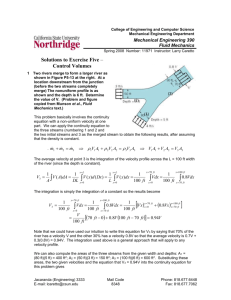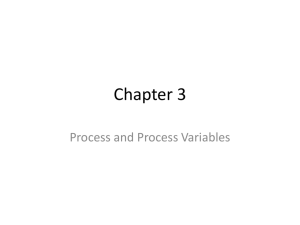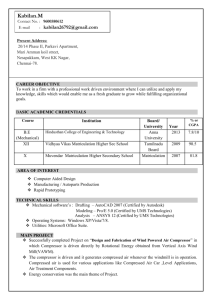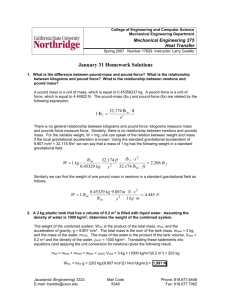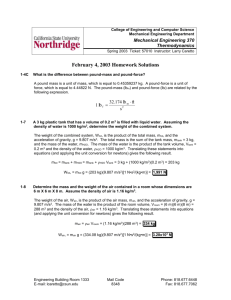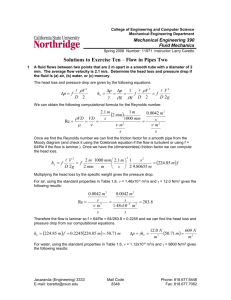March 4
advertisement
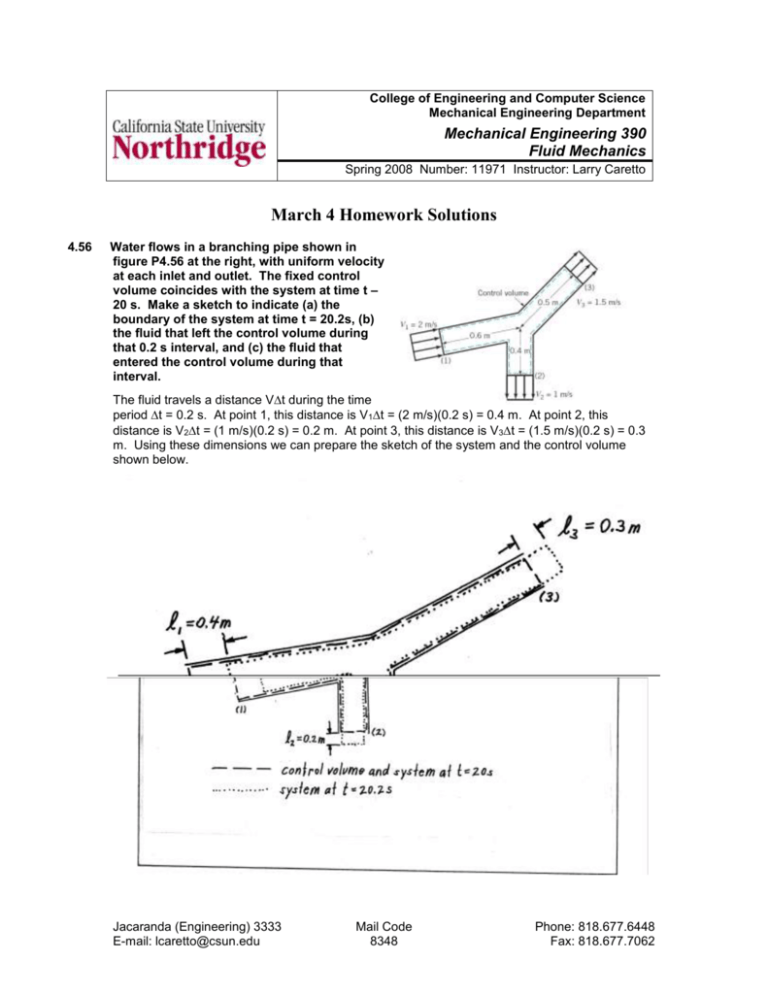
College of Engineering and Computer Science Mechanical Engineering Department Mechanical Engineering 390 Fluid Mechanics Spring 2008 Number: 11971 Instructor: Larry Caretto March 4 Homework Solutions 4.56 Water flows in a branching pipe shown in figure P4.56 at the right, with uniform velocity at each inlet and outlet. The fixed control volume coincides with the system at time t – 20 s. Make a sketch to indicate (a) the boundary of the system at time t = 20.2s, (b) the fluid that left the control volume during that 0.2 s interval, and (c) the fluid that entered the control volume during that interval. The fluid travels a distance Vt during the time periodt = 0.2 s. At point 1, this distance is V1t = (2 m/s)(0.2 s) = 0.4 m. At point 2, this distance is V2t = (1 m/s)(0.2 s) = 0.2 m. At point 3, this distance is V3t = (1.5 m/s)(0.2 s) = 0.3 m. Using these dimensions we can prepare the sketch of the system and the control volume shown below. Jacaranda (Engineering) 3333 E-mail: lcaretto@csun.edu Mail Code 8348 Phone: 818.677.6448 Fax: 818.677.7062 March 4 homework solutions 3.61 ME 390, L. S. Caretto, Spring 2007 Page 2 The wind blows across a field with an approximate velocity profile shown in Figure P4.61 shown at the right. Use equation 4.16 with the parameter b equal to the velocity to determine the momentum flow rate across the vertical surface A-B which is of unit depth into the paper. Equation 4.16 gives the following expression for the flow of a quantity b B bV ndA A In this case, b is actually a vector quantity, V = Vi, where i is the unit vector in the x direction. From the graph we see that V = (1.5/s)y between 0 and 10 feet and V = 15 ft/s between 10 and 20 ft. We can thus write our integral as follows noting that n = i, and b is the vector quantity, V V(Vi i)dA ViVdA i V 2 d wy B bV ndA B A A A A Here we have used the fact that i▪I = 1 and the differential area, dA = wdy where w is the width of one ft into the page. Substituting the relationship between V and y given above gives the following result for the integral. 2 20 ft 10 ft 1.5 2 15 ft B i V 2 d wy iw V 2 dy iw y 2 dy dy s 0 s A y 10 ft 10 ft 2 1.5 2 y 3 1.5 2 10 ft 3 15 ft 2 ft 3 15 ft 20 ft iw iw y 10 ft iw 3000 2 s 10 dr s 3 s s 3 s 0 Using the standard density of air = 0.00238 slugs/ft3 and the given unit width, w = 1 ft, gives the final answer as 2 0.00238 slugs ft 3 ft 3 1 lb f s B iw 3000 2 i1 ft 3000 2 7.14i lb f s ft 3 s slug ft 5.7 Water flows along the centerline of a 50-mmdiameter pipe with an average velocity of 10 m/s and out radially between two large circular disks as shown in Figure P 5.7 at the right. The disks are parallel and spaced 10 mm apart. Determine the average velocity of the water at a radius of 300 mm in the space between the disks. This is a basic continuity equation problem with constant density so that Q = V1A1 = V2A2. The desired velocity is found as follows A1 10 m 25 mm 1.04 m/s . A2 s 2 300 mm10 mm 2 V2 V1 March 4 homework solutions 5.11 ME 390, L. S. Caretto, Spring 2007 Page 3 At cruise conditions air flows into a jet engine at a steady rate of 65 lb m/s. Fuel enters the engine at a steady rate of 0.60 lbm/s. The average velocity of the exhaust gases is 1500 ft/s relative to the engine. If the engine exhaust effective cross section is 3.5 ft2, estimate the density of the exhaust gases in lb m/ft3. This is a problem of mass conservation and use of the continuity equation. The exhaust mass is he sum of the air mass flow rate and the fuel mass flow rate: 65 lbm/s + 0.60 lbm/s = 56.60 lbm/s. This mass flow rate of exhaust must be equal to the density-velocity-area product, VA, for the exhaust. We can thus solve for the unknown density. 65.60 lbm m s 1500 ft VA 3.5 ft 2 s 5.12 = 0.0125 lbm/ft3 Air at standard atmospheric conditions is drawn into a compressor at the steady rate of 30 m3/min. The compressor pressure ratio, pexit/pinlete, is 10 to 1. Through the compressor p/n remains constant with n = 1.4. If the average velocity in the compressor discharge pipe is not to exceed 30 m/s calculate the minimum discharge pipe diameter required. We can apply the continuity equation to this problem with 1 as the inlet and 2 as the outlet. 1V1 A1 1Q1 2V2 A2 2V2 D22 4 Solving this equation for D2 in terms of Q1 gives. . D2 4 1Q1 2V2 Since p/n = constant, p1/1n = p2/2n. Making this substitution and substituting numerical data gives. . 5.23 D2 p 4 1Q1 1 2V2 p2 1n 4Q1 1 V2 10 1 1.4 30 m 3 4 s 30 m s D2 = 0.064 m . The Hoover Dam backs up the Colorado River and creates Lake Mead, which is approximately 115 miles long and has a surface area of approximately 225 square miles. If during flood conditions the Colorado River flows into the lake at a rate of 45,000 cfs and the outflow from the dam is 8000 cfs, how many feet per 24-hour day will the lake level rise? This is a transient continuity problem. If we assume that the density and area are constant we can write the equation as follows dm d V d Ah dh A m in m out Qin Qout dt dt dt dt If we assume that the flow rates are constant so that the derivative becomes a finite difference we have the following result. March 4 homework solutions A h Qin Qout t ME 390, L. S. Caretto, Spring 2007 Page 4 45000 ft 3 8000 ft 3 3600 s 24 h s s h Q Qout t h in 2 A 225 mi2 5280 ft mi h = 0.0510 ft
